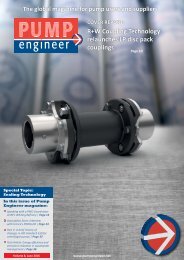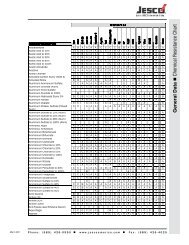KZWja
KZWja
KZWja
- No tags were found...
You also want an ePaper? Increase the reach of your titles
YUMPU automatically turns print PDFs into web optimized ePapers that Google loves.
90PROCEEDINGS OF THE FOURTEENTH TURBOMACHINERY SYMPOSIUMDEVELOPMENT HISTORY OF WIND ENERGYTECHNOLOGYThe development history of wind energy is basically areview of improvements in blade design. Since the PersianPanemones of 200 B.C. (Figure 1), two principal factors havelimited its use worldwide: limits in blade design, which haverestricted machine efficiency, and the economics of other energyresources. The importance of blade design becomes veryclear after a review of the equation for conversion of the kineticenergy of the wind to power.whereP =powerp = air densityA = area swept by rotor in square feetV = wind speed in miles per hour [5](1)As the eighteenth and nineteenth centuries advanced, theinvention of the steam engine, along with the shift from anagrarian to an industrial society, changed the economics ofwind power. The invention of cheaper, more efficient, andmore reliable steam energy technology created the first constraintto the use of wind power. By the 1800s, the number ofwind machines in Europe had diminished to under twothousand. Ironically, it was in the 1800s that wind power firstgained major influence in the United States [5].Westward expansion into the more remote, arid parts ofthe United States demanded technology to pump water. In theearly 1800s, the first American wind machines were developedfor this purpose. These metal, multiblade machines were notvery efficient, but their slow speeds and blade mass producedthe torque needed to lift water. It is estimated that by the mid-1800s wind provided 25 percent of non transportation energy.Hundreds of companies were producing thousands of waterpumpers with many different models derived from the samebasic theme. However, by the 1980s, the introduction ofcheaper and more efficient electrical pumping broughteconomic factors into play that reduced the use of wind powerin the United States, except in very remote rural areas [4].WindBlades_/Figure 1. Schematic View From Above of a PersianPanemone-Designed and Operated About 200 B.C.Because little can be done about air density or wind speedexcept locating a machine in a favorable site, most improvementsin the efficiency of wind machines have concentrated onthe blade design.The Persians' first vertical axis wind machine (Panemones),while useful, had limited efficiency because only half ofthe total blade or paddle area could be exposed to the wind at atime. By 100 A. D., the first horizontal axis applications were inuse around the Mediterranean Sea as water pumps. Usingsmall cloth sails as blades, these machines represented a stepforward in blade design, because the entire blade area wasexposed to the wind (4].Such advances in blade design first began to occur innorthern Europe in 1200 A. D. Brought back from the Mediterraneanby the Crusaders, these advances consisted of largercloth sails which converted wind energy into mechanical energyfor pumping water, grinding grain, and eventually runningsmall industrial facilities. Having developed machines capableof delivering up to 90 hp in strong winds, the Dutch andDanish made dramatic advances in the application of basichorizontal axis technology, so that by the seventeenth centuryover 25,000 windmills were in use in northern Europe (4].BLADE TECHNOLOGY EVOLVES-THEAIRFOILBy 1900, technological advances in Europe and theUnited States had set the stage for the next significant improvementin blade design, the application of a true airfoil.Prior to, and just after, World War I, development in aviationtechnology improved the wind machine blade efficiency. Windmachines, with fewer blades and reduced mass, allowed higherrotational speeds, which were better suited to the productionof electricity.Although wind turbine generators had become muchmore efficient in design, the economics of wood, oil, andnatural gas as fuels limited the use of wind power to designsunder 5 kW. Larger machine development was also constrainedby the cost of the increased mass needed to support largerblades. A few exceptions to these constraints on large machinedesign were:Denmark-Hundreds of medium-size machines (20-30kW) were deployed prior to 1914 to provide the Danish dairyindustry with remote power. These machines were refurbishedand used during World War II when other energy sources werescarce [2].Russia-In 1913, a 100 kW machine was built andoperated on the shore of the Black Sea. The machine ran for anumber of years in parallel with a 20 MW steam turbine somemiles away [2].The United States-The largest electrical generatingmachine developed prior to 1945 was installed at Grandpa'sKnob in Vermont in 1939. Constructed and operated by theSmith-Putnam Company, the 1250 kW machine producedintermittent power from 1939 to 1945. In 1945, a blade rootfailure caused the loss of one of the two 8-ton blades. Ironically,the problem had been foreseen and new blades had beendesigned, and were to be manufactured after World War II.However, the accident, combined with post-World War IIeconomics, did not justify repair and operation [6].During World War II, world oil shortages caused manycountries, such as Denmark, to reactivate and use old nonoperatingwind machines; however, economic factors changedafter the war and limited efforts to develop wind poweroccurred.During the period 1945-1973, the principal efforts to usewind power took place in Europe. The Danish built a 60 kW, a70 kW, and a 200 kW WTG, the latter running from 1958 to






